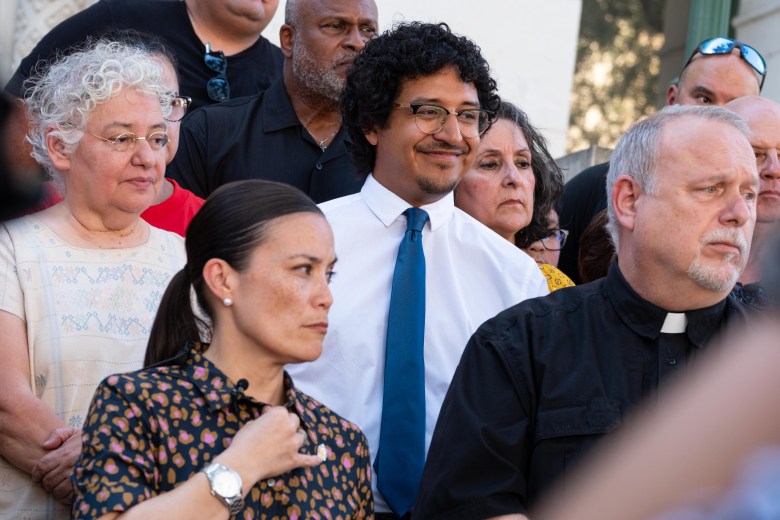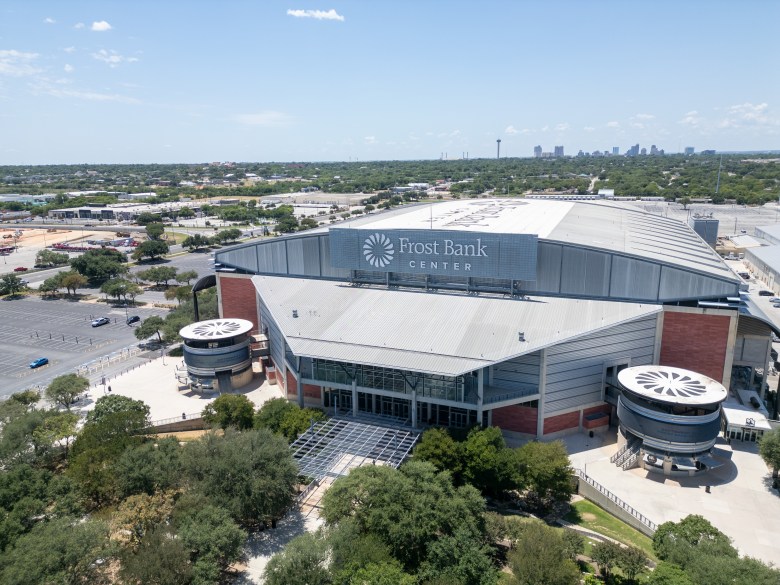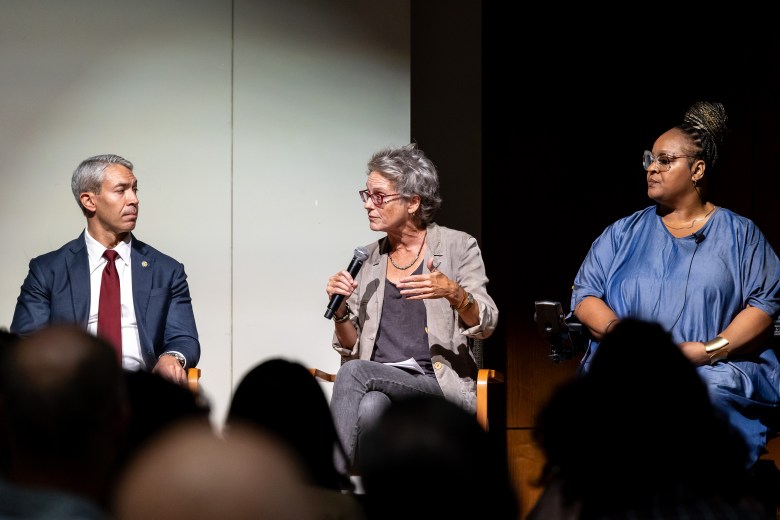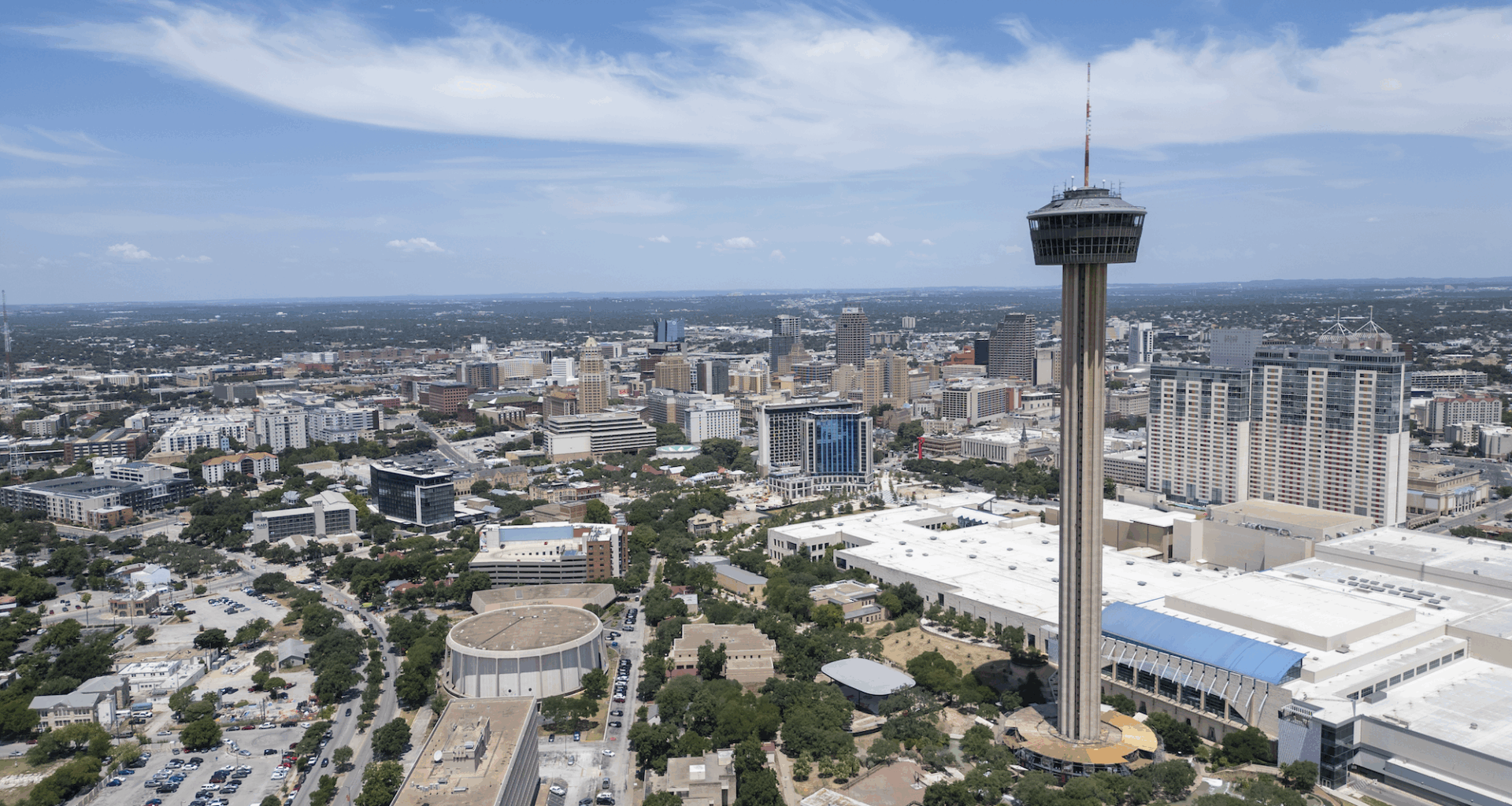Local officials are finalizing negotiations for a new downtown arena for the San Antonio Spurs, but there’s still one potential sticking point: the call for an “independent economic analysis.”
San Antonio City Council is heading toward a showdown Thursday, when council members will choose between approving a funding agreement with the Spurs and Bexar County for the $1.3- to $1.5-billion arena or listening to calls from Mayor Gina Ortiz Jones to slow down and assess more fully what it will cost.
One economic study for the arena already exists: David Stone, a consultant employed by the Spurs, spent six months working with team officials to put together a 29-page analysis of the new arena. He was asked to figure out what kind of economic effects — spending, job creation and tax revenues — a new downtown arena would create.
Stone looked at data from the Spurs, like how the NBA team’s current Eastside home the Frost Bank Center performs annually, and made assumptions about new spending and a new arena would perform.
 District 6 Councilmember Ric Galvan and San Antonio Mayor Gina Ortiz Jones stand with community members during a press conference about Project Marvel outside of City Hall on Monday. Credit: Amber Esparza / San Antonio Report
District 6 Councilmember Ric Galvan and San Antonio Mayor Gina Ortiz Jones stand with community members during a press conference about Project Marvel outside of City Hall on Monday. Credit: Amber Esparza / San Antonio Report
A group of council and community members plus Jones quickly raised concerns about bias and want to know more about the assumptions that underlie Stone’s work.
Several crucial aspects of the project were not assessed in Stone’s analysis, according to Christine Drennon, a Trinity University professor who focuses on development and urban geography, like which San Antonio businesses will be boosted by a new sports and entertainment district and what the alternatives are for the arena site.
“The first real question is: who is going to benefit?” Drennon said.
The city ordered and paid for a separate economic analysis conducted by CSL International to study a new sports and entertainment district known as Project Marvel, but decided to use Stone’s data to analyze the arena itself.
City Manager Erik Walsh said the economic analysis only played a small role in negotiations with the Spurs. City officials prioritized not using existing city funds to pay for the arena, lowering the city’s risk, getting community benefits and ensuring development near the arena while keeping the Spurs in San Antonio.
Walsh also said he would look into an independent economic analysis at Jones’ request while moving negotiations forward. The mayor called for that analysis in the next 30 to 90 days.
The November deadline looms. Stone’s study took six months. Good research, in Drennon’s words, takes time.
What were Stone’s assumptions?
Much of the public conversation about economic analysis has revolved around the study by CSL International, a research company with ties to Legends, a venue and live events company. But CSL did not conduct an analysis on the proposed arena, just the surrounding development.
The decision to use Stone’s analysis was made by City of San Antonio staff, Walsh said.
“When the city hired CSL, the charge was to evaluate the full Sports & Entertainment District — the arena, convention center, Alamodome, music venue, hotels, and surrounding development,” Walsh said in a Tuesday email. “With respect to the arena, we opted to have CSL reference information from the analysis by Stone Planning, LLC to avoid the duplication of work.”
John Kaatz, a CSL staff member, freely admitted at an Aug. 6 council meeting that CSL relied heavily on Stone’s work to assess the impact of the arena itself.
Stone began his analysis for the Spurs in July 2024 after previously assessing projects like the most recent NBA arena in Los Angeles, the Intuit Dome. He has also worked on arenas in Seattle and New Orleans.
He got historical data from the Spurs, looking at attendance and spending patterns from the last four non-COVID basketball seasons. He then used that data to “estimate the annual, both historical and future, economic impacts” of Marvel.
Stone said the analysis makes assumptions about how many people will attend events, how many people will be hired to run the arena and how attendees’ spending will ripple across a community.
Stone assumed that having two arenas — the old Frost Bank Center and the new downtown arena — would add around 600,000 attendees at San Antonio events each year and more than double the demand for local hotel stays by venue attendees.
However, when asked for more detail about hotel nights and attendee projections, Stone said the projected operations for both arenas were put together by another consultant who is not credited or named in the report.
Liberty Smith, a Spurs spokesperson, said those estimates were based on the fact that the San Antonio Stock Show and Rodeo could increase its attendance and programming with year-round offerings, plus the Spurs could do more in the month of February, when the rodeo normally takes over the Frost Bank Center.
“The rodeo is eager to expand their programming, and then we’re eager to have a comprehensive full season in the arena, as well,” Smith said. The Spurs did not name the consultant who prepared the operation projections as of publication time.
Stone said other cities could handle two arenas successfully when it comes to hosting concerts and other events, but he also noted that San Antonio is a unique market.
 Drone shot of the Frost Bank Center in August 2025. Credit: Cooper Mock for the San Antonio Report
Drone shot of the Frost Bank Center in August 2025. Credit: Cooper Mock for the San Antonio Report
“It’s hard to give an absolute answer because every situation is different, every market is different,” Stone said. “But, in general, for the average, generic market, if you’re replacing an older, somewhat outdated NBA arena with a brand-new NBA arena, something like the Intuit Dome, you could be pretty confident that you’re going to get more events than you have in the past.”
Stone was more certain about his estimate that roughly 100 direct jobs would be added because of the new arena. Commitments from the Spurs to hire more staff and the need to staff two arenas, not one, made that number more concrete. He also estimated a small number of indirect jobs would also be created by more business in the downtown area.
Stone estimated direct spending at the new arena bring in an additional $225 million a year, and could ripple out as businesses make money and then spend it again on wages and supplies.
That spending will probably take place close to the arena and not necessarily across the city, Stone said, but without data about which types of local businesses are in the area and how the spending would be distributed between them, predictions are hard to make.
Experts cry foul
Those are exactly the questions that should be asked in an independent assessment, said Drennon, who called for a better analysis during public comment at the Aug. 6 meeting.
She said it was important to do that research and properly understand who benefits from investing hundreds of millions of public dollars.
“A decent study is going to take you several months,” Drennon said. “Decent research takes a long time.”
Brandli Stitzel, a West Texas A&M professor of economics who has studied construction of Oklahoma City’s new arena and projects at the University of Oklahoma, said the spending effects of Stone’s study were more conservative than usual, but were still unrealistic.
“Those numbers are arbitrary at best,” Stitzel said. “We know when we do studies after, we don’t see those multipliers.”
 Christine Drennon, associate professor of sociology and anthropology at Trinity University, speaks during a panel discussion at Whitley Event Center. Credit: Bria Woods / San Antonio Report
Christine Drennon, associate professor of sociology and anthropology at Trinity University, speaks during a panel discussion at Whitley Event Center. Credit: Bria Woods / San Antonio Report
Economic impact analyses often include multipliers as money is spent and spent again in an economy, but Stitzel said those multipliers are often inflated. Stone used multipliers from the U.S. Department of Commerce that raised the $225 million in additional direct spending to $318 million in additional indirect spending in the city.
Consultants can be incentivized to look for benefits based on careers working for teams, Stitzel said, when often, building new arenas for existing teams with public funds does not create a large-scale economic benefit.
Most sports attendees are local residents, Stitzel said, and a lot of their money would be spent in the arena rather than at surrounding businesses. Rather than create new economic activity, it just moves spending around, he said.
“Decades of academic research show that the net economic impact of sports teams and stadiums on local economies is effectively zero,” Stitzel said.
As it currently stands in negotiations, Bexar County could put in up to $311 million, depending on the outcome of the November election. City council members will decide whether or not to commit up to $489 million on Thursday.
The Spurs have committed to covering everything else, starting at $500 million, which would be between 33% and 38% of the arena cost, and could be higher if there are cost overruns.
Other NBA projects in Sacramento, Milwaukee and Detroit were more than 50% privately funded, Stitzel said, and new arenas in San Francisco and Los Angeles were completely privately funded.
“The proposed San Antonio arrangement would represent one of the least favorable public deals in recent memory — surpassed only by the recent Oklahoma City agreement,” Stitzel said.
In that case, the Oklahoma City Thunder are contributing $50 million to a nearly fully publicly funded $900 million arena.
Stitzel said sports arenas made up relatively small parts of a city’s overall economy — the city website puts San Antonio’s total GDP at $168 billion — but he and Drennon noted that sports teams have deeper community meaning.
“With the Spurs, it’s not just economic benefits, it’s social and cultural,” Drennon said.
The Spurs have also made financial offers that go beyond the arena. In a statement Monday, the team said it would contribute $75 million over 30 years for a community benefits agreement.
Spurs officials and private developers have also guaranteed $1.4 billion in development around the new arena, potentially adding businesses and economic opportunities nearby.
Council members will decide whether to accept the Spurs’ offer — or pause — Thursday.
